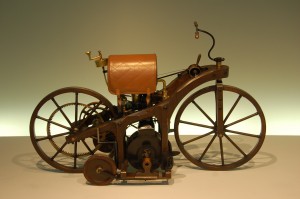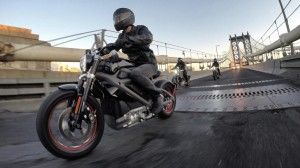 Contributed by Declan McGuire, Sea change – The ghosts of technology past is another in our series of occasional features.
Contributed by Declan McGuire, Sea change – The ghosts of technology past is another in our series of occasional features.
This article originally appeared in the September 2014 issue of Bike Buyers Guide, through which MAG Ireland has been afforded the opportunity to explore some of the challenges facing riders today.
Sea change – The ghosts of technology past.

Image credit: Imperial War Museum/Wikimedia commons
In the days before the humble shipping container, ocean going freighters had to be loaded and unloaded by manual labour. Trucks turning up at port could be forced to sit idle for hours, sometimes days, awaiting a work gang to physically unload the cargo piece by piece. The goods then sat in a warehouse or on the pier until another gang could physically load the lot into the hold of a waiting ship.
At busy ports like Liverpool or New York thousands of dock workers were required to move cargo on and off these freighters. Any ship owner or trucking company which fell foul of the dock workers unions might find that their ships or trucks didn’t get loaded or unloaded. Governments too were fair game, since everything coming in our out of the country went via the docks. An all-out strike could potentially paralyse an entire economy, as dock workers and ministers alike knew only too well.

Image: Wikipedia
Legend has it that in 1937 truck driver Malcom McClean was queueing at Jersey pier when it dawned on him that it would be a lot quicker and a whole lot easier to just crane the entire truck onto the ship. It is said that this flash of inspiration led to his later purchasing a war surplus tanker and modifying it to carry 33 foot long steel containers.
In truth, containers had been around in one form or another long before McClean’s legendary epiphany but what he succeeded in doing was bringing containerisation from niche to mainstream. It didn’t happen overnight, but with standard sizes and methods eventually agreed, shipping containers gained a foothold. Economics and rising oil prices did the rest.
There’s been a great deal written about Harley Davidson’s recent unveiling of a prototype electric motorcycle. Doubtless this deluge of publicity for a mere prototype must frustrate manufacturers like Brammo and Zero who face an uphill task in marketing actual working electric bikes that, unlike the Harley, you can buy and ride today.
There’s a problem of perception at work here. Motorcycle riders, as a group, have a tendency to distrust new technology on motorcycles. Just about every technological advance in motorcycling has been met with an undercurrent of resistance, although granted, not always without some reason.
Early fuel injection systems, for example, simply couldn’t match the silky smooth delivery that almost a century of carburettor refinement had delivered. Manufacturers persevered simply because emissions regulations meant that fuel injection was the only way forward. Carbs, for all their fine-tuned finesse were suddenly a dead end street when the regulations changed.
Doubtless similar resistance was met when manufacturers moved from drum brakes to disc, from 6 volt to 12 volt, two stroke to four stroke, or any number of advances in the technology of building motorcycles. As a group, we have a tendency towards tradition, a distinct preference for evolution over revolution.

Daimler Motorcycle
Image: Wikipedia
It is perhaps partly for this reason that electric motorcycles remain a niche product. With their inherent power to weight advantages, motorcycles ought to be the ideal target for electric propulsion. Indeed in 1885 when Gottlieb Daimler squeezed his early internal combustion engine into a rudimentary wooden beam frame with a wheel at each end he did so because his half-horsepower 264cc motor was just too gutless to drive anything heavier.
Electric motorcycles today are in their infancy compared to their petrol driven counterparts because we’ve spent the last 120 odd years improving upon Daimler’s original internal combustion engine to the point where today’s electronically managed variant is incredibly efficient at burning recycled dinosaurs. Had we put the same effort into developing batteries, we’d be in a very different place today.
Science and engineering will one day crack the energy density problems that limit the range of today’s electric motorcycles. There’s been plenty of progress down that road already as John McGuinness demonstrated with a 117 mph lap of the TT on an electric bike this past June. It’s a question of when, not if, electric bikes break into the mainstream.
Or is it? According to the SEAI, the body which administers the electric vehicle grant scheme in Ireland, only passenger or light commercial vehicles qualify. It’s still early days of course, and regulations can change, but right now the approved list of vehicles doesn’t contain a single motorcycle. You’ll get generous VRT rebates for an approved vehicle made by BMW, Citroen, Mitsubishi, Nissan, and Renault, but if you buy an electric bike you’re on your own. Ireland’s not about to incentivise motorcycling, electric or otherwise, any time soon.

Harley’s electric prototype
So what Harley Davidson has done, and arguably what Harley Davidson was the only company capable of doing, is to bring the concept of the electric motorcycle out of the shadows and put it squarely front and centre in the minds of those who know absolutely nothing whatsoever about motorcycles or motorcycling. The sort of dull and unimaginative people who draw up electric vehicle grant policy perhaps?
For all its development and efficiency, the internal combustion engine will one day become a relic of a bygone age when oil was cheap and plentiful. Whether we as motorcyclists pass into history with it depends to some extent on regulations and on policy from the likes of the SEAI, but possibly more so our willingness to overcome our inherent traditionalism and embrace change.
When science eventually cracks the battery problem, and it will, economics and rising oil prices will do the rest. We can sail on that tide or be drowned by it.
You may well believe your way of life can’t be swept away by some new technology or an obscure change in regulations. Wander the docksides of Dublin, Liverpool or London today and you’ll see little trace of the working army which once held sway here. The distant echoes of their world are the now converted warehouses, a museum here or a sculpture there. This is what it looks like when an entire way of life disappears.
MAG Ireland has been afforded the opportunity to explore some of the challenges facing riders today through a column in Bike Buyers Guide. With a wide selection of news, views and reviews it’s Ireland leading motorcycle magazine. Out monthly for €4.99 in all good newsagents.
